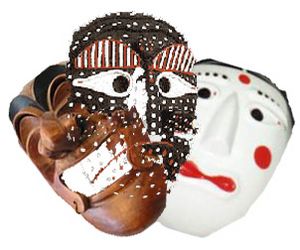Korean mask facts for kids
| Korean mask | |
 |
|
Quick facts for kids Korean name |
|
|---|---|
| Hunminjeongeum |
탈
|
| Hanja |
倛
|
| Revised Romanization | tal |
| McCune–Reischauer | t'al |
Korean masks have a long tradition with the use in a variety of contexts. Masks of any type are called tal in Korean, but they are also known by many others names such as gamyeon, gwangdae, chorani, talbak and talbagaji. Korean masks come with black cloth attached to the sides of the mask designed to cover the back of the head and also to simulate black hair.
Purpose
They were used in war, on both soldiers and their horses; ceremonially, for burial rites in jade and bronze and for shamanistic ceremonies to drive away evil spirits, to remember the faces of great historical figures in death masks, and in the arts, particularly in ritual dances and theatrical plays. The present uses are as miniature masks for tourist souvenirs, or on cell-phones where they hang as good-luck talismans.
There are two ways to group masks: religious masks and artistic masks. Religious masks were often used to ward off evil spirits and the artistic masks were mostly used in dances and theater shows.
Dance masks
There are about 250 types of masks which are used for dance in Korea and they vary in shape. Masks in the central district usually look pretty and similar to the human face, and in the southern province masks are for satire and ritual.
Shamanistic masks
The often horrifying or ugly masks were used in shamanistic practices for their ability to bring fear and humor in ceremonial rites. The masks were often made of alder wood, with several coats of lacquer to give the masks gloss, and waterproof them for wearing. They were usually also painted, and often had hinges for mouth movement.
Images for kids
See also
 In Spanish: Máscaras coreanas para niños
In Spanish: Máscaras coreanas para niños








